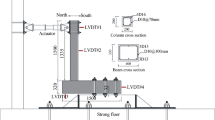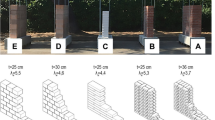Abstract
Low shear strength of historical masonry constructions is a matter of great concern, especially when these buildings are located in areas of high seismic risk. In recent years this issue has led to many investigations on the development of innovative reinforcement techniques. The application of cement mortar, commonly used in this type of reinforcements, involves a number of material incompatibility problems that could be overcome with the use of lime-based binder mortars. The present article presents the results of an experimental study on solid mock brick wallets reinforced with thin layers of mortar mixed with glass fibers; Diagonal compression tests have been carried out to determine the behaviour of the reinforced masonries, evaluated both in terms of shear strength and deformation capacity. Test results verify that the coating of mortar mixed with fibers is practically as effective as cement mortar regarding shear strength, while they improve deformation capacity.










Similar content being viewed by others
References
ElGawady M, Lestuzzi P, Badoux M (2004) A review of conventional seismic retrofitting techniques for URM. In: 13th international brick and block masonry conference, pp 1–10
Valluzzi MR, Tinazzi D, Modena C (2002) Shear behavior of masonry panels strengthened by FRP laminates. Constr Build Mater 16(7):409–416. https://doi.org/10.1016/S0950-0618(02)00043-0
Foster PB, Gergely J, Young DT, McGinley WM, Corzo A (2005) FRP repair methods for FRP repair methods for unreinforced masonry buildings subject to cyclic loading. Spec Publ 230:289–306
Triantafillou TC (1998) Strengthening of masonry structures using epoxy-bonded FRP laminates. J Compos Constr 2(2):96–104. https://doi.org/10.1061/(ASCE)1090-0268(1998)2:2(96)%23sthash.FSWTZicj.dpuf
Taghdi M, Bruneau M, Saatcioglu M (2000) Seismic retrofitting of low-rise masonry and concrete walls using steel strips. J Struct Eng 126(9):1017–1025. https://doi.org/10.1061/(ASCE)0733-9445(2000)126:9(1017)%23sthash.GD90VIZd.dpuf
Rosenboom O, Kowalsky M (2003) Investigation of alternative details for seismic design of post-tensioned clay masonry walls. In: Proceedings of the 9th NAMC, Clemson, SC, USA, pp 475–485
Valluzzi MR, Binda L, Modena C (2005) Mechanical behaviour of historic masonry structures strengthened by bed joints structural repointing. Constr Build Mater 19(1):63–73. https://doi.org/10.1016/j.conbuildmat.2004.04.036
Chuxian S, Guiqiu L, Wenchao W (1997) The design of brick masonry structure with concrete column. In: Proceedings of the 11th IB2MaC, Shanghai, China, pp 14–16
Kahn L (1984) Shotcrete retrofit for unreinforced brick masonry. In: 8th WCEE, vol 583, p 590
Hutchison D, Yong P, McKenzie G (1984) Laboratory testing of a variety of strengthening solutions for brick masonry wall panels. In: 8th WCEE, San Francisco, USA, pp 575–582
Gattesco N, Boem I, Dudine A (2015) Diagonal compression tests on masonry walls strengthened with a GFRP mesh reinforced mortar coating. Bull Earthq Eng 13(6):1703–1726. https://doi.org/10.1007/s10518-014-9684-z
Witzany J, Zigler R, Kroftová K (2016) Strengthening of compressed brick masonry walls with carbon composites. Constr Build Mater 112:1066–1079. https://doi.org/10.1016/j.conbuildmat.2016.03.026
Papanicolaou CG, Triantafillou TC, Karlos K, Papathanasiou M (2007) Textile-reinforced mortar (TRM) versus FRP as strengthening material of URM walls: in-plane cyclic loading. Mater Struct 40(10):1081–1097. https://doi.org/10.1617/s11527-006-9207-8
Messali F, Metelli G, Plizzari G (2017) Experimental results on the retrofitting of hollow brick masonry walls with reinforced high performance mortar coatings. Constr Build Mater 141:619–630. https://doi.org/10.1016/j.conbuildmat.2017.03.112
Sevil T, Baran M, Bilir T, Canbay E (2011) Use of steel fiber reinforced mortar for seismic strengthening. Constr Build Mater 25(2):892–899. https://doi.org/10.1016/j.conbuildmat.2010.06.096
Facconi L, Conforti A, Minelli F, Plizzari GA (2015) Improving shear strength of unreinforced masonry walls by nano-reinforced fibrous mortar coating. Mater Struct 48(8):2557–2574. https://doi.org/10.1617/s11527-014-0337-0
Arandigoyen M, Bernal JP, López MB, Alvarez JI (2005) Lime-pastes with different kneading water: pore structure and capillary porosity. Appl Surf Sci 252(5):1449–1459. https://doi.org/10.1016/j.apsusc.2005.02.145
RILEM TC 167-COM (2005) Introduction to requirements for and functions and properties of repair mortars. Prepared by Van Balen K, Papayianni I, Van Hees R, Binda L, Waldum A. Materials and Structures 38:781–785
Lanas J, Alvarez-Galindo JI (2003) Masonry repair lime-based mortars: factors affecting the mechanical behavior. Cem Concr Res 33(11):1867–1876. https://doi.org/10.1016/S0008-8846(03)00210-2
Lanas J, Bernal JP, Bello MA, Galindo JA (2004) Mechanical properties of natural hydraulic lime-based mortars. Cem Concr Res 34(12):2191–2201. https://doi.org/10.1016/j.cemconres.2004.02.005
Seabra MP, Labrincha JA, Ferreira VM (2007) Rheological behaviour of hydraulic lime-based mortars. J Eur Ceram Soc 27(2–3):1735–1741. https://doi.org/10.1016/j.jeurceramsoc.2006.04.155
Arizzi A, Viles H, Cultrone G (2012) Experimental testing of the durability of lime-based mortars used for rendering historic buildings. Constr Build Mater 28(1):807–818. https://doi.org/10.1016/j.conbuildmat.2011.10.059
Maravelaki-Kalaitzaki P, Bakolas A, Karatasios I, Kilikoglou V (2005) Hydraulic lime mortars for the restoration of historic masonry in crete. Cem Concr Res 35(8):1577–1586. https://doi.org/10.1016/j.cemconres.2004.09.001
Silva BA, Pinto AF, Gomes A (2014) Influence of natural hydraulic lime content on the properties of aerial lime-based mortars. Constr Build Mater 72:208–218. https://doi.org/10.1016/j.conbuildmat.2014.09.010
Arandigoyen M, Alvarez JI (2007) Pore structure and mechanical properties of cement–lime mortars. Cem Concr Res 37(5):767–775. https://doi.org/10.1016/j.cemconres.2007.02.023
Silva BA, Pinto AF, Gomes A (2015) Natural hydraulic lime versus cement for blended lime mortars for restoration works. Constr Build Mater 94:346–360. https://doi.org/10.1016/j.conbuildmat.2015.06.058
Giuriani E, Marini A (2008) Wooden roof box structure for the anti-seismic strengthening of historic buildings. Int J Archit Herit 2(3):226–246. https://doi.org/10.1080/15583050802063733
Gattesco N, Macorini L (2014) In-plane stiffening techniques with nail plates or CFRP strips for timber floors in historical masonry buildings. Constr Build Mater 58:64–76. https://doi.org/10.1016/j.conbuildmat.2014.02.010
EN 1996-1-1 (2012) Eurocode 6—design of masonry structures—Part 1-1: general rules for reinforced and unreinforced masonry structures. European standard
EN 1052-3 (2007) Methods of test for masonry. Part 3: determination of initial shear strength. European standard
EC8, Eurocode EN (1998) European Union norm on construction. Design of structures for earthquake resistance
ASTM E519-2010 (2010) Standard test method for diagonal tension (shear) in masonry assemblages. American Society for Testing Material
RILEM LUMB6 (1994) Diagonal tensile strength tests of small wall specimens (1991). Rilem recommendations for the testing and use of constructions materials. RILEM, pp 488–489
Alecci V, Fagone M, Rotunno T, De Stefano M (2013) Shear strength of brick masonry walls assembled with different types of mortar. Constr Build Mater 40:1038–1045. https://doi.org/10.1016/j.conbuildmat.2012.11.107
Calderini C, Cattari S, Lagomarsino S (2010) The use of the diagonal compression test to identify the shear mechanical parameters of masonry. Constr Build Mater 24(5):677–685. https://doi.org/10.1016/j.conbuildmat.2009.11.001
Corradi M, Tedeschi C, Binda L, Borri A (2008) Experimental evaluation of shear and compression strength of masonry wall before and after reinforcement: deep repointing. Constr Build Mater 22(4):463–472. https://doi.org/10.1016/j.conbuildmat.2006.11.021
Mahmood H, Ingham JM (2011) Diagonal compression testing of FRP-retrofitted unreinforced clay brick masonry wallettes. J Compos Constr 15(5):810–820. https://doi.org/10.1061/(ASCE)CC.1943-5614.0000209%23sthash.0ZvlWUjl.dpuf
Brignola A, Frumento S, Lagomarsino S, Podesta S (2008) Identification of shear parameters of masonry panels through the in situ diagonal compression test. Int J Archit Herit 3(1):52–73. https://doi.org/10.1080/15583050802138634
Borri A, Castori G, Corradi M (2015) Determination of shear strength of masonry panels through different tests. Int J Archit Herit 9(8):913–927. https://doi.org/10.1080/15583058.2013.804607
EN 1015 (2007) Methods of test for mortar for masonry—Part 11: determination of flexural and compressive strength of hardened mortar. European standard
EN 772-11 (2011) Methods of test for masonry units—Part 11: determination of water absorption of aggregate concrete, autoclaved aerated concrete, manufactured stone and natural stone masonry units due to capillary action and the initial rate of water absorption of clay masonry units. European standard
EN 772-1 (2011) Methods of test for masonry units—Part 1: determination of compressive strength. European standard
EN 197-1 (2011) Cement—Part 1: composition, specifications and conformity criteria for common cements. European standard
EN 459-1 (2016) Building lime—Part 1: definitions, specifications and conformity criteria. European standard
EN 1015-12 (2000) Methods of test for mortar for masonry—Part 12: determination of adhesive strength of hardened rendering and plastering mortars on substrates. European standard
RILEM, 50-FMC (1986) Committee fracture mechanics of concrete, determination of the fracture energy of mortar and concrete by means of three-point bend test on notched beams. Mater Struct 18:285–290
García-Cuadrado J, Rodríguez A, Cuesta II, Calderón V, Gutiérrez-González S (2017) Study and analysis by means of surface response to fracture behavior in lime-cement mortars fabricated with steelmaking slags. Constr Build Mater 138:204–213. https://doi.org/10.1016/j.conbuildmat.2017.01.122
EN 1052-1 (1999) Methods of test for masonry—Part 1: determination of compressive strength. European standard
EN 1052-3 (2007) Methods of test for masonry—Part 3: determination of initial shear strength. European standard
Malyszko L (2004) In-plane shear and tensile strength tests of small brickwork specimens. In: Proceedings of structural analysis of historical constructions, pp 291–298
Turnšek V, Čačovič F (1971) Some experimental results on the strength of brick masonry walls. In: Proceedings of the 2nd international Brick Masonry conference, pp 149–156
Author information
Authors and Affiliations
Corresponding author
Ethics declarations
Conflict of interest
The authors declare that they have no conflict of interest.
Additional information
Publisher's Note
Springer Nature remains neutral with regard to jurisdictional claims in published maps and institutional affiliations.
Rights and permissions
About this article
Cite this article
Bustos-García, A., Moreno-Fernández, E., Zavalis, R. et al. Diagonal compression tests on masonry wallets coated with mortars reinforced with glass fibers. Mater Struct 52, 60 (2019). https://doi.org/10.1617/s11527-019-1360-y
Received:
Accepted:
Published:
DOI: https://doi.org/10.1617/s11527-019-1360-y




